
En route to Shimla, I called on the army chief, General N.C. Vij. He congratulated me on my new assignment, and during our interaction, he asked me to write the doctrine for the army as the GOC-in-C of ARTRAC. There had to be two parts to it – one for the public domain, and the other classified, covering operational aspects. I started working on this from day one. The salubrious climate of Shimla was extremely conducive for creativity and conceptual work. My office was in a historical building, constructed in the nineteenth century to house the General HQ of the British Imperial Army. Though the top two floors of the seven- or eight-storeyed building had got burnt down, it was still a very imposing building. The fact that the office had been occupied by the likes of General Lord Roberts of Kandhar (1885–93), General Viscount Kitchener of Khartoum (1902–09), General Sir Philip W. Chetwode (1930–35), whose words are enshrined in the Chetwode Hall of the Indian Military Academy, General Sir Claude J.E. Auchinleck and General Sir Archibald P. Wavell (the second last governor general of India), to name a few, who were all commanders-in-chief of the Indian Army, was an unbelievable high. What must have happened in the exalted wood-panelled and teak-floored chambers and corridors of this famous building is impossible to imagine or describe. The Command House, where we lived for a year, was named the Retreat. It was one of the best houses that I have ever stayed in, and was constructed in 1904 during the glorious period of the Raj.
I formed a team to do research for writing the army doctrine. It was evolved keeping in mind the lessons learnt in previous wars, including Kargil and the recently concluded Operation Parakram. We had frequent review meetings and discussed various issues that arose. My experience of Exercise Poorna Vijay, Operation Parakram, and the seminar on heavy breakthrough helped me in formulating the doctrine for offensive operations in the plains and desert. It also addressed our concerns in the mountains. This doctrine was a visionary document in which the futuristic challenges were analysed and we talked of fighting the future war. By the end of the year, we had the draft of the document ready. After considerable deliberations, it was approved and released the next year by the army chief.
All important training institutions of the army came under the Army Training Command. Therefore, I had a lot of travelling to do. We reviewed and published a book on leadership and another on training in the Indian Army, called Quest for Excellence. During the annual training conference in 2003, I laid great emphasis on information technology, geographical information systems, aerial and satellite imagery, communications and night fighting capabilities. We developed indigenous war gaming models based on computers and began training officers at unit level in a facility in Delhi Cantonment. I also encouraged the development of simulators for gunnery, driving, aviation and in other applications. Where necessary, we made our bids for import of such equipment. We raised a simulator division in the Electronic and Mechanical Engineering College at Secunderabad. Computerized war gaming and simulators reduced the need for exercises in the field and enhanced the life of equipment due to less wear and tear, thereby generating a lot of savings. Citing the example of Operation Desert Storm, the US campaign in Iraq during 1991–92, I exhorted officers to study the use of high technology, especially surveillance, acquisition and destruction of targets, with precision-guided munitions, so as to be able to obtain a decisive result in the shortest possible time frame, and with the minimum casualties.
During December 2003, it was announced that I would be the next GOC-in-C of Western Command. It is one of our most prestigious commands with its HQ at Chandimandir, a military station near Chandigarh. We felt very sad at the thought of leaving the pristine environment of the Shimla hills.
Towards the end of January, Shimla and its surroundings again witnessed very heavy snowfall. It was snowing in the morning as we left for Chandimandir and the road was covered with two feet of snow. It was sheer coincidence, but it had also snowed the day I took over the reins of the Army Training Command at Shimla, and it proved to be a good omen. Our Ambassador cars got stuck so we had to abandon them and get into 4x4 jongas fitted with non-skid chains to drive down.
Western Command is an operational command unlike the ARTRAC, which had no operational role. It was responsible for the defence of the western border from J&K upto Rajasthan during the 1965 and 1971 wars. Later, Northern Command was carved out from it to assume operational responsibility for J&K. Presently, it looks after the defence of the most politically sensitive and precious heartland of Punjab.
Therefore my first priority was to visit and familiarize myself with the latest situation in our area of operational responsibility (AOR). Though I had commanded 9 Infantry Division, which formed a part of Western Command, things had changed after Operation Parakram. We had realigned the theatre boundaries on the entire western border with Pakistan. At the end of my tenure as GOC 1 Corps, I had been entrusted by the army chief to do a study to bring out the lessons from Operation Parakram. Based on the recommendations of this study, the inter-command boundaries were changed and a new South Western Command was raised at Jaipur, as well as a new Corps HQ at Yol, about 70 kilometres east of Pathankot. This readjustment of boundaries came about after a lot of discussions and the overruling of many objections raised by HQ Northern Command – the objections smelt of petty turf issues. My first concern was to integrate the additional AoR in the Jammu sector into the Western Command plans. This arrangement would inherently create greater synergy for the defence of our AoR. Besides, we were also able to create more reserves and enhance the inherent offensive defence capabilities in the theatre.
In order to validate the new doctrine, the Strike Corps was asked to conduct an offensive exercise, named Sange Shakti, in the obstacle-ridden plains of the Punjab. Besides launching appropriately grouped task forces within a short time from their peace locations, the exercise also highlighted our capability in network-enabled functioning and the use of UAVs. A number of visits were undertaken by me to review operational readiness and to meet soldiers in border cantonments. I stressed upon thorough knowledge of the operational task and the terrain, and a high state of maintenance of weapon systems and equipment. All ranks should know the ground like the back of their hand. During this tenure, I was honoured by President A.P.J. Abdul Kalam with the Param Vishisht Seva Medal for distinguished services of the highest order at the Rashtrapati Bhawan.
Realizing the growing importance of the role of the media, we held a seminar on army-media relationship and were successful in conducting useful interactive sessions. Many important strategic analysts and media personalities participated in this event. There were unusually heavy monsoon rains in Himachal Pradesh and Punjab in 2004. The cloud burst that took place in the catchment areas of Himachal Pradesh resulted in the flooding of the entire Ambala-Patiala belt. Many people became homeless and there was a huge loss of property and livestock. We made a large number of army aviation sorties with relief material alongwith the air force, and saved lives of many marooned people.
Around September–October 2004, inspired and motivated articles began to appear in the media about the race for the next army chief, as General N.C. Vij was scheduled to retire on 31 January 2005. I was cautioned by some friends that there were a lot of ‘dirty tricks’ played by rivals in such succession battles not only in the armed forces, but in all domains of public service. There was nothing that one could do about it except to guard one’s flanks through friends and well-wishers, and leave the rest to destiny. I was the natural successor to the then chief of army staff as I was not only going to be the seniormost at that time but also equally good, if not more meritorious, as compared to other competitors. Although it was never a consideration as far as I was concerned, some people were speculating whether or not the government would appoint a Sikh officer as the army chief. If it did so, it would be the first instance in the history of independent India of a Sikh leading a 1.3-million-strong Indian Army. Setting aside all speculation, the government decided to do precisely that. The greatest chapter of my life was about to begin.

Laying a wreath at Amar Jawan Jyoti, India Gate, New Delhi, 1 February 2005.

Dad and Rohini pipping me as a ‘four star’ general, 31 January 2005.

Blessings of mom and dad on my becoming the chief of army staff, 31 January 2005.

Ceremonial Guard of Honour by 7 Maratha LI on my taking over as chief of army staff, Army HQ New Delhi, 31 January 2005. (Maj Rohit Choudhary commanded the parade.)
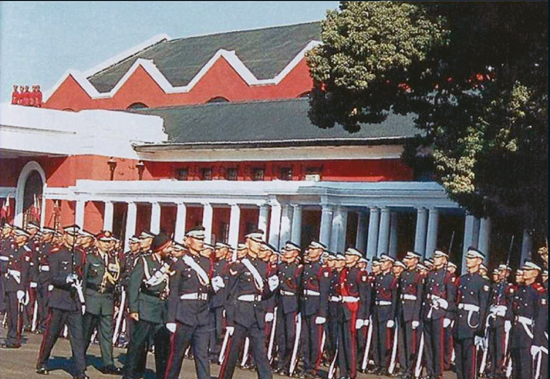
Reviewing the passing out parade at the Indian Military Academy, Dehradun, December 2006.

A content chief and first lady of the army, February 2005.

Tête-à-tête with General Guo Boxiong, vice chairman of central military commission, Great Mall of the People, Beijing, 21 May 2007. Nirupama Rao, then ambassador to China, is on extreme left.

Calling on Mis Majesty Jigme Singye Wangchuck, king of Bhutan, 2005.

Receiving the medals of Field Marshal S.H.F.J. Manekshaw for the Indian Army, Stavka, Nilgiris, 2006.

Ceremonial welcome on board PLA Navy frigate at Shanghai Naval Base on 25 May 2007.

Reviewing the traditional and ceremonial Guard of Honour at Whipple Field, Washington DC, 7 November 2006.

Honouring the widow of a martyr and her braveheart son in combat dress at the Maratha LI Centre, Belgaum, 2007.

‘Fight to Win’ – raising the morale of my warriors at Siachen, 2005.
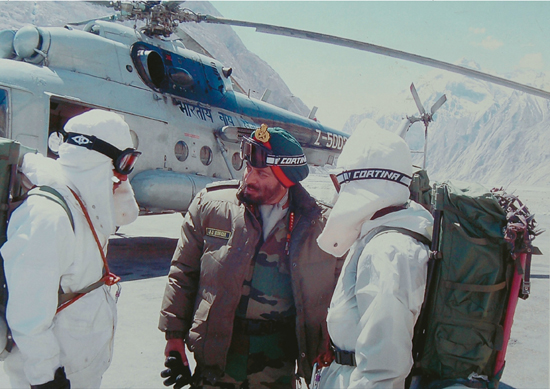
With ‘glacier warriors’, Siachen, 2005.
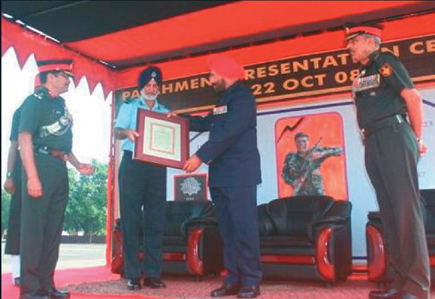
Affiliation of the Maratha LI with the air force (above) and navy (below).
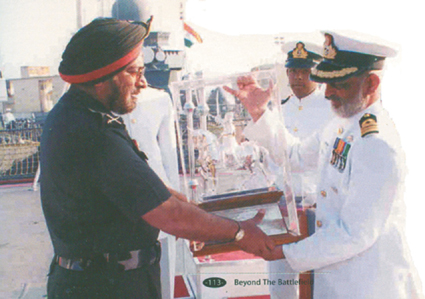
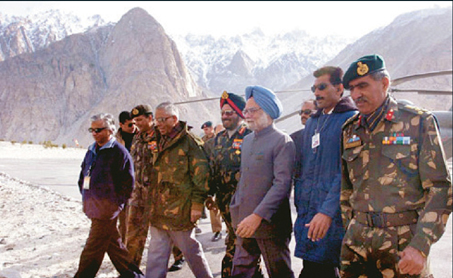
The first visit by a prime minister to Siachen: with Dr Manmohan Singh, M.K. Narayanan, T.K.A. Nair and Brig Om Prakash, 2005.

Calling on President Pratibha Devisingh Patil, 2007.

Visiting earthquake-devastated Uri in Kashmir, October 2005, with Sonia Gandhi, Defence Minister Pranab Mukherjee, Chief Minister Ghulam Nabi Azad and Ambika Soni.
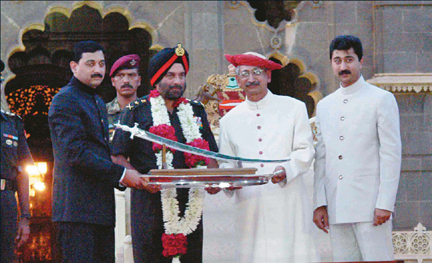
Receiving the ‘traditional’ sword of honour from Shahu Chhatrapati Maharaj, whose lineage goes back to Chhatrapati Shivaji Maharaj, Kolhapur, 2006.

‘Aman Setu’ cake at Army Day reception, New Delhi, January 2006.
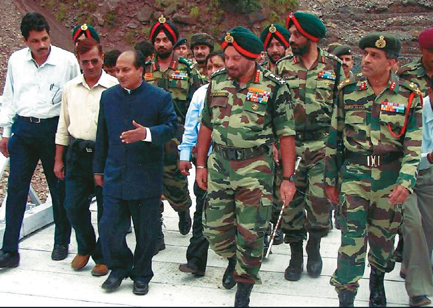
Crossing the newly constructed ‘Aman Setu’ (bridge of peace) on the Line of Control in Uri Sector, Kashmir, 2006 (with Defence Minister A.K. Antony, GOC-in-C Northern Command Lt Gen H.S. Panag, GOC 19 Inf Div Maj Gen R. Halgalli and Deputy MA Col P.J.S. Pannu).

On board aircraft carrier INS Virat, with Admiral S. Menta, the naval chief, and MA Brig V.S.S. Goudar, 2007.

Presiding over an army commanders’ conference, October 2006.
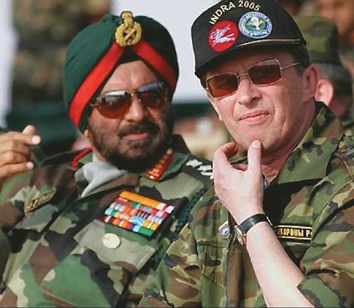
With Russian Defence Minister Sergei Ivanov at the joint Indo-Russian exercise ‘INDRA 2005’ in Rajasthan.

Saluting the Colours of 61st Cavalry during review of the ceremonial mounted parade in Jaipur, 2007.

Defence Minister A.K. Antony bidding me farewell in the presence of the minister of state for defence, M.M. Pallam Raju, and senior armed forces officers, September 2007.

Rohini and I at the Pangong Tso lake near the Line of Actual Control with China in Ladakh, 2005.

Presenting the humane face of the army, Srinagar, 2006.

Receiving the Brahmos missile system from President A.P.J. Abdul Kalam and Dr Sivathanu Pillai, CEO Brahmos, 2006.

With Sonia Gandhi at Army Day reception, New Delhi, January 2007.
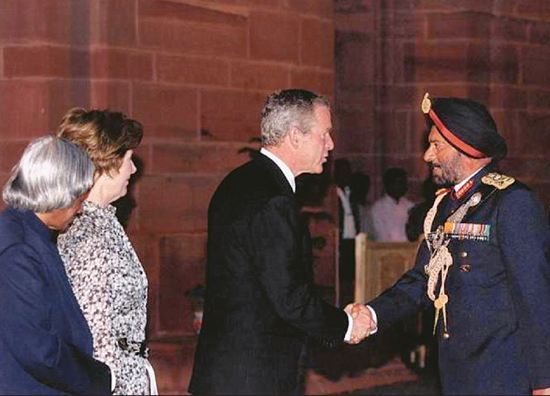
Meeting US President George Bush, with President A.P.J. Abdul Kalam and Laura Bush, Rashtrapati Bhavan, New Delhi, March 2006.